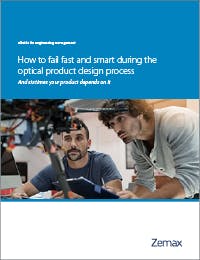Shorten time to market, even when engineers are in short supply
The United States remains the global leader in science and technology, according to the National Science Foundation. Engineering plays a major role in helping the country stay at the top of the list, and Bureau of Labor Statistics projects there will be 1.265 million engineering job openings between 2016 and 2026. Yet according to some experts, there is only one qualified individual per 1.9 STEM job listings, indicating a shortage of engineering talent. In optics specifically, experts point to a need to foster and grow more optical and optomechanical engineering talent in order to help propel the industry forward.
A shortage in qualified engineers focused on optical design
There has been a recent uptick in job listings for optical engineers at Apple. Microsoft, Facebook, Google, and Amazon are also hiring engineers focused on optical product design. With the field of optics touching nearly every industry, from virtual reality to autonomous vehicles to the biomedical industry, the number of open jobs points to a shortage in qualified engineers focused on optical design right now—and the potential for that trend to continue.
Productivity tools can help ease the burden of an open head count
Open head count can lead to falling behind schedule as teams work to fill hiring gaps with qualified individuals while also trying to push toward product development milestones. Oftentimes there is an extra burden on optical and mechanical engineers to translate data across unique platforms. In an ideal scenario, they can work in their own familiar tools, while retaining the optical design integrity.
Virtual prototyping can significantly streamline the optical design process. According to a report by Knowledge Sourcing Intelligence, “The major benefit of virtual prototyping is that it enables engineering teams to analyze their model visually and mathematically before making a hardware prototype which saves cost, time, and efforts considerably. The need to minimize time and cost while maximizing quality in manufacturing industry where competition is intensive fuels the global virtual prototype market. Moreover, rising demand from end-user industries is also propelling the market growth.”
New eGuide: the time and money saving solution from Zemax
Zemax Virtual Prototyping is the only solution to create a virtual prototype of the entire optomechanical product—not just the optical or mechanical components alone. Zemax Virtual Prototyping consists of highly integrated software that streamlines optical product development. Learn how to reduce costs and shorten time to market, even when engineers are in short supply.

